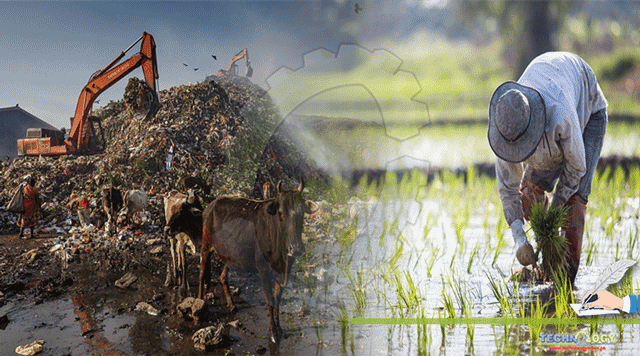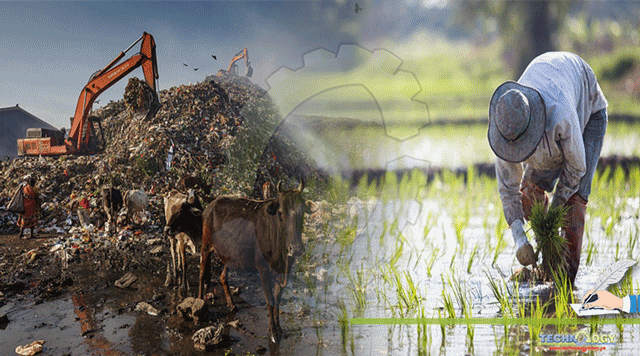Water Management Has Been Considered As One Of The Methods That Can Be Used To Decrease Methane Emissions From Flooded Rice Conditions.

“In the 21st century one of main issue in science is climate change. Rice is main source in agriculture in methane production.” One of the main issues in science and technology in the 21st century is climate change which is due to numerous factors contributing to it. A long-lasting argument is on sources that are responsible for climate change. In the light of scientific researches, many man-made activities are contributing to greenhouse gas emissions including carbon dioxide, nitrous oxide and methane.
The agriculture sector is contributing 20% to greenhouse gases on a yearly basis contribution. Soil is considered to be a sink of these gases so to mitigate or reduce the emissions strategies are to be developed. In global warming, methane has 25 times more capability than carbon dioxide because it absorbs more heat. Methane is one of the major causing global warming as its concentration is increasing by 1.8 ppm over 300 years.
Sources of methane emission from Agriculture
- Rice field
- Crop residues burning
- Livestock rearing
- Manure management
In global food, security rice is playing a vital role. It is being grown in 114 countries around the globe in diverse climates and ecosystems. Rice is the staple food for half of the people and demand is projected to be increased by 28% up to the year 2050. Wetland rice agriculture is an important source of methane emission and is contributing 20-26% to global climate change.
Three key functions are to be related to methane emissions in rice which includes:
- Aerenchyma in rice causes methane to escape into the air
- It also provides the substrate for methane productions by methanogens
- Oxidation of methane in the rhizosphere by supporting oxygen counter- transport through aerenchyma system
STRATEGIES TO METHANE EMISSIONS IN PADDY
Soil Additives
Soil amendments such as sulphate containing amendments including ammonium sulphate fertilizer and gypsum could be an effective option to reduce methane emission from the rice field. This approach however can not reduce up to 100% but it is often recommended in such conditions. the mechanism behind this is due to the presence of sulphate both methane-producing bacteria known as methanogens and sulphate reducing bacteria will compete for the same substrate which is hydrogen+ carbon dioxide or acetate used by Methanogens for methane productions and will lead to a reduction to methane emissions. Sulphate reducing bacteria is more competent than methanogens so this competition will lead to the reduction of methane emission from paddy.
Another soil additive that could be used is nitrification inhibitors including acetylene and nitrapyrin known to have the potential of inhibiting nitrifiers, methanogens and methane oxidizers. Controlling methane emission by controlling straws in addition to rice flooded condition is also an approach. As decomposition of these straw produces methane. By making sure that straw does not decay in the flooded condition the growth of methanogens could be discouraged. The addition of organic amendments will enhance aeration in the soil so it is also advised to add with continuous removal of weeds from rice flooded conditions as weeds are investigated to be the source of methane production.
Endophytic Bacteria
Endophytic microorganisms such as methanotrophs have been found promising in mitigating methane production in crops other than rice. This is due to the ability of methanotrophs to metabolize methane by biological oxidation.
Water Management
Water Management Has Been Considered As One Of The Methods That Can Be Used To Decrease Methane Emissions From Flooded Rice Conditions. Due to periodic drainage oxidative conditions can be improved resulting in the promotion of root activity, increased soil bearing capability as it introducing oxygen into the soil and reducing methane production.
Breeding Approaches
Rice varieties obtained by breeding for best quantities with low methane production is also a mitigation option. In general, it could be said that the more days the rice crop remain in flooding condition the more will be methane production so by shifting to short-duration varieties from long-duration varieties the methane emissions could ultimately be reduced up to 25%.
Conclusion
This article summarizes all the possible ways of production and escape of methane into atmosphere contributing to climate change. The production of methane is contributing to global warming which is warming the climate. In Agriculture rice is considered main source and can be reduce by various strategies.
